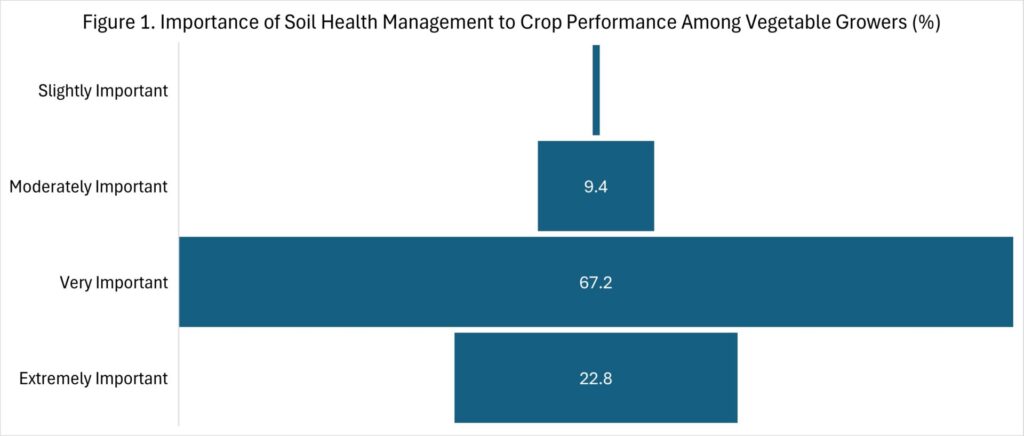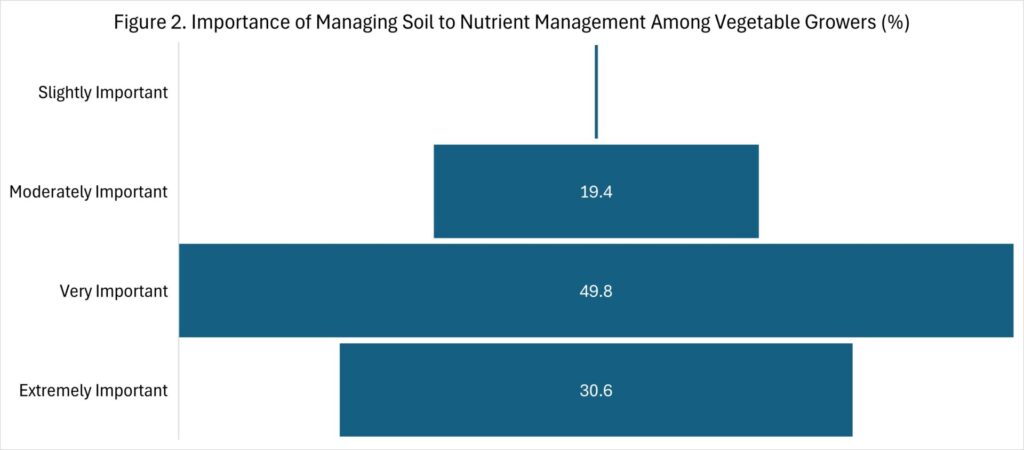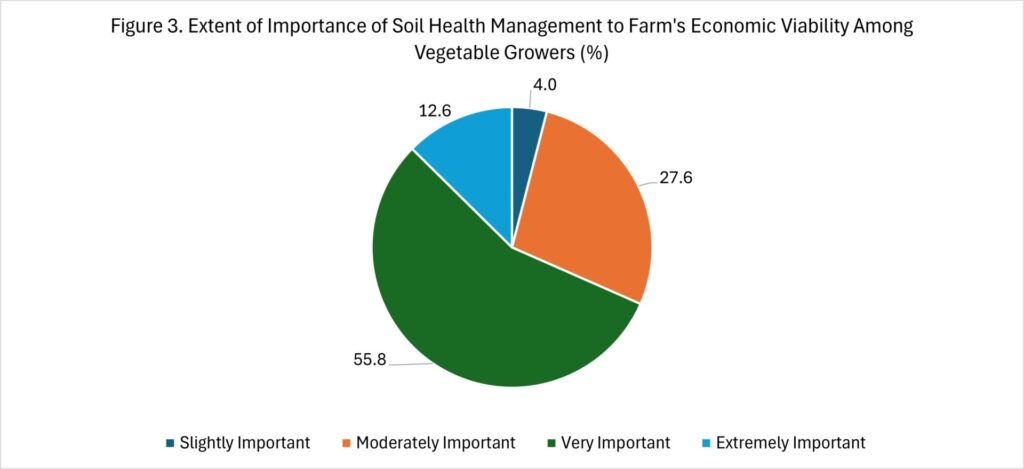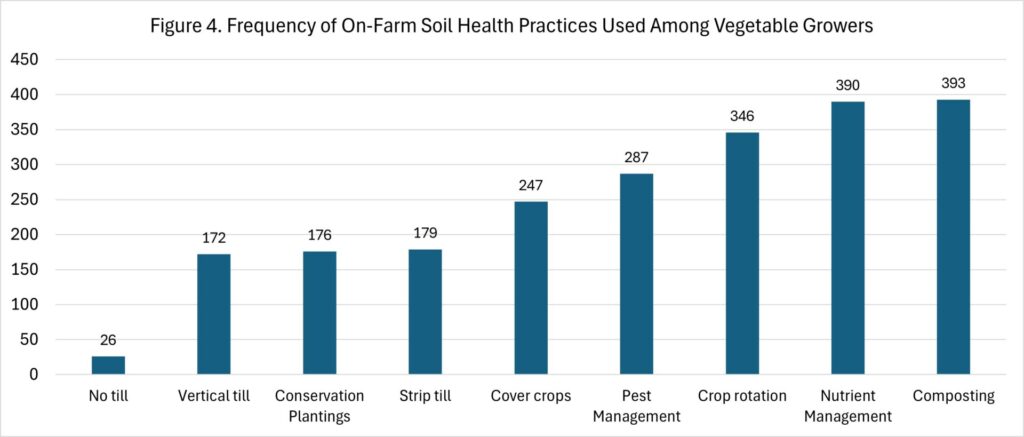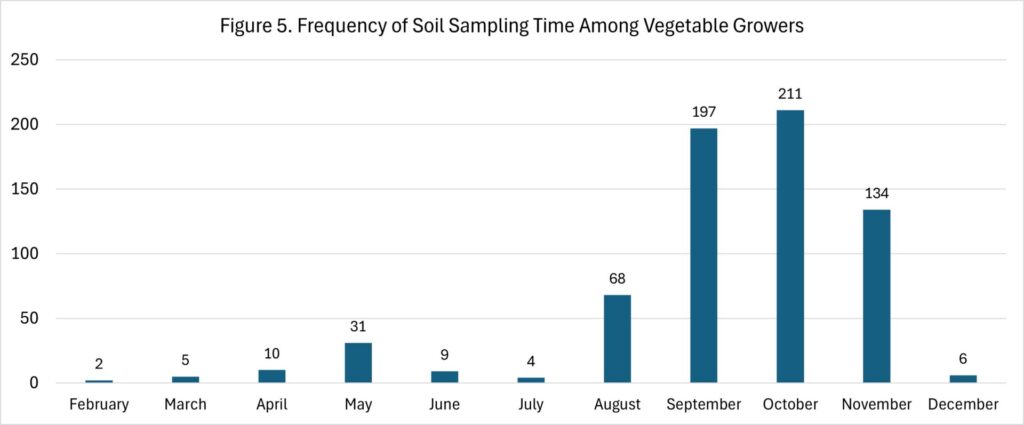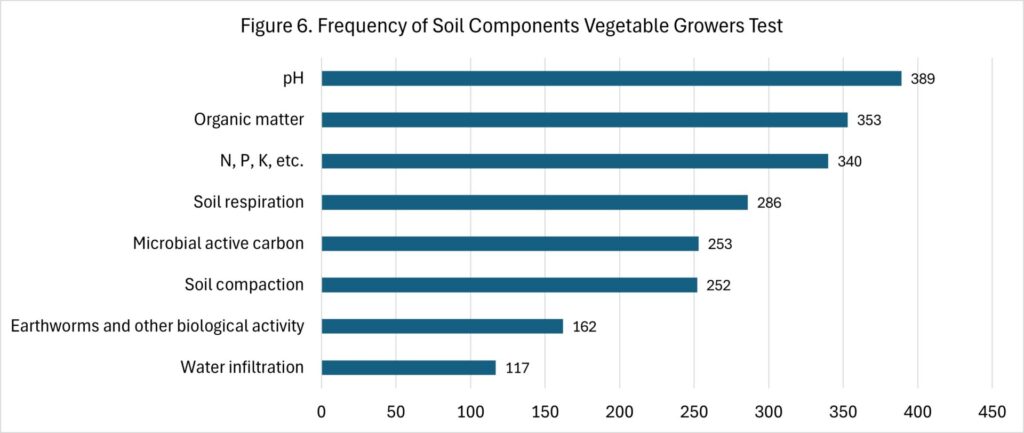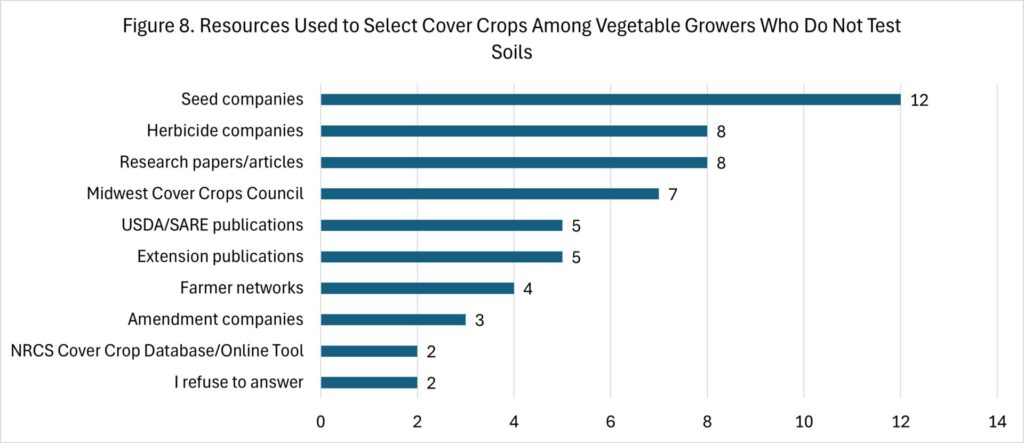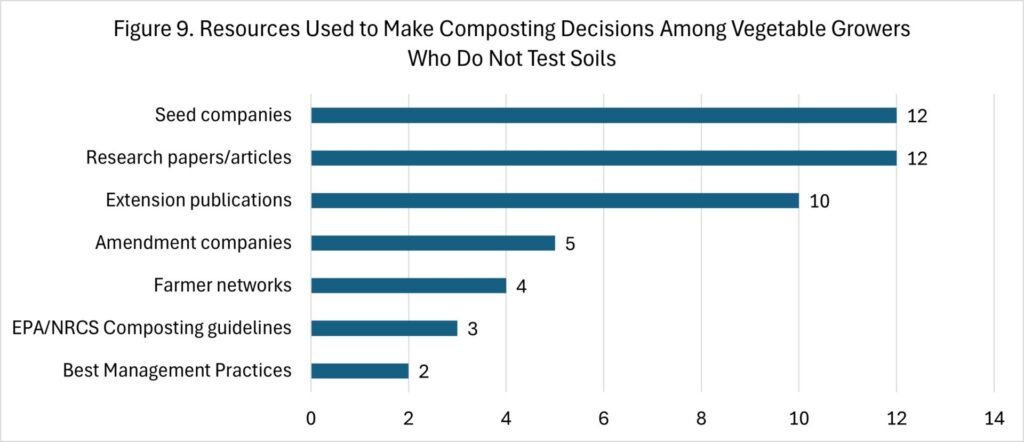Small and medium-sized vegetable farms face unique challenges balancing profitability with sustainable production practices and food safety requirements. To better understand how these farmers navigate complex decision-making processes, the Soil to Market Team—comprising Maria Marshall, Renee Wiatt, Petrus Langenhoven, Betty Feng, and Nathan Shoaf—conducted a comprehensive survey of 500 small and medium-sized farmers across the United States during 2024-2025. This research, funded by the U.S. Department of Agriculture’s National Institute of Food and Agriculture, focuses on holistic farmer decision-making processes.
This article series will present key findings from the survey, offering insights that can help both growers and Extension educators better understand the interconnected nature of farm planning. These findings aim to support more profitable and sustainable vegetable farming operations by examining the relationship between strategic planning and farm performance.
From Soil to Market: How Integrated Decision-Making Drives Vegetable Production Success
Recent survey data reveal that vegetable growers are increasingly adopting integrated management approaches that recognize soil health as the foundation of successful crop production and economic viability. The findings demonstrate a shift toward comprehensive decision-making that connects soil management practices directly to market outcomes.
The Dominance of Integrated Production Systems
The survey shows that 89.6% of growers operate using both organic and conventional practices, with only 8.4% using purely conventional methods and just 2% using exclusively organic approaches. This mixed systems model reflects the practical reality that modern vegetable production requires flexibility to meet diverse market demands while maintaining soil health and economic sustainability.
This integrated approach allows growers to optimize their management strategies based on specific crops, market requirements, and field conditions, rather than being constrained by a single production practice.
Soil Health as the Production Foundation
Growers clearly understand that soil health underpins successful vegetable production. An overwhelming 67.2% consider soil health “very important” to crop performance, with an additional 9.4% rating it as moderately important (Figure 1). This recognition extends beyond immediate production concerns to long-term sustainability and profitability.
The connection between soil health and nutrient management is even more pronounced, with 80.4% of growers rating soil health as “very important” or “extremely important” to their nutrient management programs (Figure 2). This suggests that growers view soil health not only as an environmental approach, but also as a practical tool for optimizing fertilizer efficiency and reducing input costs.
Economic Drivers of Soil Health Investment
The economic case for soil health management is clear in the survey result, as 68.4% of growers consider soil health “very important” or “extremely important” to their farm’s economic viability (Figure 3). This economic perspective drives adoption of soil health practices that can reduce input costs, improve yields, and enhance crop quality—all factors that directly impact market competitiveness.
Comprehensive Soil Health Practice Adoption
Growers are implementing a diverse range of soil health practices (Figure 4), with composting leading adoption at 78.6% of responses, followed closely by nutrient management (78.0%) and crop rotation (69.2%). Pest management (57.4%) and cover crops (49.4%) represent the next tier of popular practices, while tillage practices show varied adoption rates, with strip till (35.8%), vertical till (34.4%), and conservation plantings (35.2%) clustering together in the middle range. No-till practices, although beneficial, show the lowest adoption rate, with just 5.2% of responses. Growers could check all that apply.
This hierarchy reflects growers’ prioritization of practices that offer multiple benefits. Composting, nutrient management, and crop rotation provide immediate improvements in soil health while supporting economic returns through enhanced soil fertility, pest suppression, and improved nutrient cycling—advantages that directly translate to increased market value.
Data-Driven Decision Making
Soil testing demonstrates growers’ dedication to evidence-based management. The majority (95.8%) of growers test their soils, with 87.4% sampling within the last five years. Most growers (71.4%) sample annually, typically during the fall months (September-November), when soil conditions are most representative and planning for the following season begins (Figure 5).
Growers test for a comprehensive range of soil parameters (Figure 6), with pH (77.8%), organic matter (70.6%), and N-P-K levels (68.0%) being the most common. Importantly, 69.5% of growers feel they can interpret test results “well”, and 66.8% follow laboratory recommendations “a lot” or “a great deal”. The responses were not mutually exclusive.
Connecting Soil Health to Crop Selection
The integration of soil health into crop planning is evident in cover crop selection practices (Figure 7). 55.7% of growers use soil test results to select cover crops, demonstrating how soil health data influences cropping decisions that affect both soil improvement and subsequent cash crop performance.
For the minority of growers who don’t use soil tests (21), they rely on a diverse network of information sources (Figure 8). Seed companies are the most frequently consulted resource (12 responses), followed by research papers and articles (8 responses), and herbicide companies (8 responses). The Midwest Cover Crops Council serves as another important resource (7 responses), while extension publications and USDA/SARE publications each garnered 5 responses. The growers could check all that apply.
Soil-Informed Composting Decisions
The survey reveals that 89.6% of growers use soil test results to make composting decisions, representing one of the highest rates of soil test integration across all management practices. This indicates that growers understand composting as a precision tool rather than a blanket soil improvement strategy.
For growers who don’t use soil tests (21), they turn to various research-based resources for composting decisions (Figure 9). Research papers and articles are tied with seed companies as the most consulted sources, followed by extension publications and amendment companies. This pattern among growers who do not use soil tests shows that growers seek evidence-based guidance for their cover crop and composting decisions.
Market Implications
This integrated approach to soil health management positions vegetable growers to meet increasingly sophisticated market demands. Consumers and buyers are showing greater interest in production practices that support environmental sustainability while maintaining high-quality produce. Growers who can demonstrate comprehensive soil health management are better positioned to access premium markets and meet certification requirements.
The survey data reveal that successful vegetable production increasingly depends on integrated decision-making that connects soil health practices to both immediate production needs and long-term market positioning. By viewing soil health as an investment in both environmental sustainability and economic viability, growers are building resilient operations that can adapt to changing market conditions while maintaining productivity.
Key Opportunities for Extension Educators and Advisory Services
The survey data reveals several strategic focus areas for Extension educators and grower advisory services:
Strengthening Soil Test Interpretation Skills: While 95.8% of growers test their soils, only 12.5% feel they can interpret results “extremely well.” This represents a significant opportunity to enhance grower confidence and decision-making through targeted educational programs on soil test interpretation.
Expanding Cover Crop Integration: With 11.5% of growers not utilizing cover crops and 32.8% not using soil tests for cover crop selection, there’s clear potential to increase adoption and improve selection strategies. Educational programs that demonstrate the economic benefits of cover crops and provide practical selection tools could drive greater adoption.
Enhancing Composting Precision: Although 89.6% use soil tests for composting decisions, the high reliance on research papers and extension publications by non-testers (12 and 10 responses, respectively) indicates a strong appetite for evidence-based composting guidance. Extension programs could focus on translating research into practical composting recommendations. This includes helping farmers align compost applications with specific crop nutrient needs to avoid over- or under-application and improve nutrient use efficiency.
Supporting Integrated Management: The dominance of hybrid organic-conventional systems (89.6%) suggests growers need guidance on optimizing integrated approaches rather than choosing between production philosophies. Educational programs that address regulatory compliance, market access, and practice optimization for mixed systems would be highly valuable.
Strengthening Research-Practice Connections: The frequent citation of research papers and articles across multiple management areas indicates growers actively seek scientific backing for their decisions. Extension services can serve as critical bridges between research findings and practical implementation.
The Path Forward for Vegetable Growers
For current and future vegetable growers, the survey data delivers a clear message: success in today’s market requires viewing soil health as both an environmental stewardship practice and a strategic business investment. The most successful operations are those that embrace integrated decision-making, combining the best practices from different production systems while maintaining rigorous soil testing and data-driven management. Growers who invest in understanding their soil test results, adopt comprehensive soil health practices, and connect these practices to market opportunities will be best positioned to thrive in an increasingly competitive and sustainability-focused marketplace. The foundation for profitable, sustainable vegetable production truly begins with the soil.
This soil-to-market perspective ensures that management decisions support both immediate profitability and long-term sustainability, positioning vegetable operations for success in an increasingly competitive and environmentally conscious marketplace.
By linking production decisions with consumer demand for sustainably grown produce, growers can build stronger branding, access premium markets, and meet evolving buyer expectations. Extension programs can play a vital role in guiding farmers through this transition by providing technical assistance, facilitating peer-to-peer learning, and helping identify emerging funding opportunities.
Reference
Wiatt, R., Marshall, M.I., Feng, Y., Langenhoven, P., and Shoaf, N. (2024-2025). Soil to Market Producer Survey on Integrated Decision-Making Survey [data file and codebook]. IRB-2024-1552. Funded by USDA-NIFA-AFRI: Taking the Next Step as a Small and Medium Sized Farm: Understanding the Integration of Production, Food Safety, and Profitability.
Funding Acknowledgement
This work is supported by the Agriculture Food Research Initiative-Small and Medium Sized Farms Program, project award no. 2021-68006-33893, from the U.S. Department of Agriculture’s National Institute of Food and Agriculture.
Any opinions, findings, conclusions, or recommendations expressed in this publication are those of the author(s) and should not be construed to represent any official USDA or U.S. Government determination or policy.

